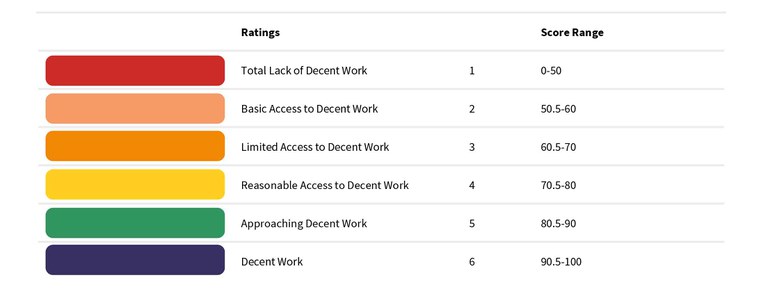The WageIndicator Foundation and the Centre for Labour Research co-produced the first edition of the Labour Rights Index in 2020. This is the second edition of the Index with 135 countries. WageIndicator Foundation, a Dutch non-profit established in 2001, works towards increased transparency in labour markets by providing access to minimum wages, living wages, and labour rights information.
2022 - The Index in Text - Explanation
With gratitude and a big smile on our faces, WageIndicator proudly presents the Labour Rights Index 2022 with the world. The Labour Rights Index is a unique Index that scores and rates 135 countries in the world on the basis of their national labour law and how these laws relate to the Decent Work Agenda of the International Labour Organisation. It is the only Index in the world that compares national labour laws at this scale.
In September 2015, 193 states decided to adopt a set of 17 goals to end poverty and ensure decent work as part of the Sustainable Development Goals (SDGs). Each goal has specific targets to be achieved over 15 years. There are 169 targets and 232 indicators listed under these 17 SDGs. The Labour Rights Index aims at an active contribution to the Sustainable Development Goals[1] by providing necessary (complementary) insights into de jure provisions on issues covered in particular by SDG 8 (Decent Jobs), SDG 5 (Gender Equality), SDG 10 (Reduced Inequalities) and SDG 16 (Strong Institutions).
The WageIndicator Foundation and the Centre for Labour Research have developed the Labour Rights Index, which looks at the status of countries in terms of providing laws related to decent work for the labour force. The data set covers 10 indicators for 135 countries. The Index aims to provide a snapshot of the labour rights present in the legislation of the countries covered.
The Labour Rights Index tracks the changes in workplace rights during the past two years.
However, some countries have enacted regressive and repressive labour legislation, undermining and frustrating workers' rights.
The section describes some major trends before delving into detail at the country level.
The Country Profiles section shows a two-page profile for each of the 135 countries covered in the Labour Rights Index 2022. The country profiles are informative about the major aspects of labour legislation in an economy.
The subtopics in a Decent Work Check (DWC)[37] have been used to structure 46 questions under the indicators in constructing this Index. However, what differentiates the Labour Rights Index from the Decent Work Checks is that it is more specific, adds newer topics like pregnancy inquiry, comparison between minimum age for employment and compulsory schooling age, and scoring of trade union questions is not solely dependent on labour legislation in the country.

Between 1 January 2020 and 1 January 2022, we recorded 54 changes to indicator scores. There were 33 countries which introduced positive legal reforms, resulting in a change of score to 1. Over the same period, 21 countries introduced negative reforms, resulting in a change in score to 0. Bangladesh, Burundi, Mongolia and Togo were the only countries to have introduced both positive and negative legal reforms affecting the provision of labour rights in these countries.
